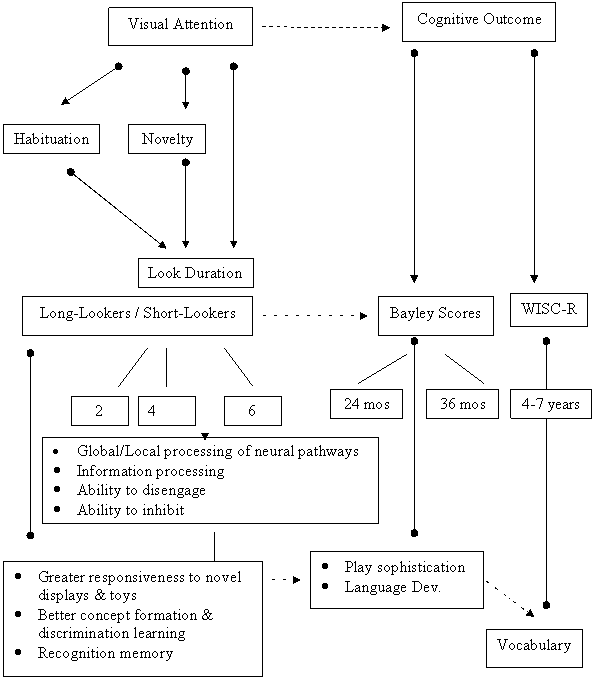Understanding visual attention in the context of well-child check-ups: Implications for practice and understanding development
Abstract
The primary aim of this study was to determine whether an experimental paradigm used to assess visual attention in infancy could be translated into a clinical setting. Infant visual attention predicts cognition in later childhood, above and beyond traditional assessment tools, such as the Bayley (BSID-II). Further, while early identification of developmental delay is critical, time constraints inherent in the pediatric setting have historically left little opportunity for the systematic assessment of many developmental issues. Therefore, one goal of this research was to identify measures of visual attention inherent to pediatric exams that would have the potential to screen for cognitive delay. Thirty-three infants were observed longitudinally at 2, 4, and 6 months, during their well-child check-ups. Standard measures of look duration were obtained using an experimental procedure.
Episodes of the physical exam were evaluated to determine whether they could be used as a proxy for experimental measures of visual attention. Measures of crying were also obtained at each age, in order to examine the hypothesized relation between attention and emotion. Temperament was assessed at 6 months to see whether a clearly definable temperamental sub-class was associated with length of looking. The Bayley (BSID-II) was administered at 6 months, and these scores were correlated with measures of visual attention.
At 2 months, one variable derived from the ‘competition’ episode of the physical exam, number of looks to the physician’s face, was highly correlated (r = .77) with the peak look to the normal face during the experimental procedure. There were no significant correlations found between visual attention measures and the exam episodes at 4 months. At 6 months, the longest look in the ‘competition’ episode (almost always to the ophthalmoscope) was positively correlated with the mean duration of fixation (r = .67) in the experimental procedure. Although some measures of crying yielded moderate to high correlations with visual attention at 6 months, measures derived from the physical exam predicted look duration above and beyond any measures of crying. Additionally, no measure of look duration at any age was significantly correlated with the Mental Development Index (MDI) score of the Bayley at 6 months, in keeping with the developmental psychology literature.
Follow-up assessments of these now preschool aged children is planned, with the expectation that 6-month visual attention scores and WISC scores at 4 years will be more highly correlated than these children’s 6-month Bayley MDI scores and WISC scores at 4 years. In determining whether these applied measures of visual attention have predictive validity in terms of later cognition, we will then be able to study in greater detail, the application of visual attention as a screening device for infants suspected to be at-risk for neurodevelopmental delay.
FIGURE 1a:
Conceptual Model of infant visual attention as it relates to cognition in later childhood.

VARIABLE |
CONSTRUCT |
HOW MEASURED |
| Demographic data | Age, maternal education, household income, race, ethnicity, breast/ formula fed, perinatal historyApgar scores |
Questionnaire
– derived from Hernandez (1997) Given at 6 months Physician report |
| Visual Attention | Attention involves selectivity, state of engagement, and higher-level control. Visual attention involves directing the eyes toward a source of information and maintaining a visual focus long enough to acquire information or solve a problem (Ruff & Rothbart, 1996). |
Behavioral indices of:
|
| Look Duration | One of the simplest and most reliable measures of visual attention. Normal infants are classified as “short” or “long” lookers on visual attention tasks according to a median split of the length of longest look. Look duration refers to how long an infant regards a visual stimulus. |
|
| Disengagement | The ability to disengage the eyes from a salient stimulus. In young infants, if eyes are directed towards a stimulus for some time, it is unlikely that infant will make peripheral refixation. However, ability to disengage is greater when there is a 2nd target to induce orienting. Long-lookers are slower to disengage (Frick et al., 1999). 2-month-olds are slower to disengage than 4 –month-olds. |
Have physician hold otoscope at midline before the baby
and allow infant to orient to it. Once this is established, move in so that
physician face is in line with the otoscope. This presents a “competing”
condition (Frick et al., 1999). Administered at 2, 4 & 6 months |
| Tracking | A measure of looking obtained when subjects follow moving objects with their eyes (Ruff & Rothbart, 1996). Involves neural mechanisms different from those that govern looking at stationary objects. |
Using the otoscope, have physician present it at infant’s
midline, wait for fixation and then assess how far and how quickly infant
visually follows object through an arc vertically, horizontally, and
diagonally Administered at 2, 4 & 6 months |
| Cry/Distress | An index of stress and emotional regulation assessed by duration of infant’s vocalizations. |
|
| Temperament | A representation of an infant’s style of reactivity, or individuality, across various dimensions. |
Revised Infant Temperament Questionnaire, Carey &
McDevitt, (1978). Completed at 6 months |
| Infant Developmental Assessment Scores | Gold standard of pediatric assessment – based on sensorimotor development and language milestones. |
Bayley Scales of Infant Development II (BSID) -MDI & PDI Administered at 6 months |
Anderson, C. M., Double Take: Transferring the Technology of Infant Visual Attention to Well Child Check-Ups. Presented at the Society for Research in Child Development Biennial Meeting, May, 2005.

